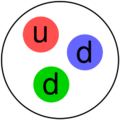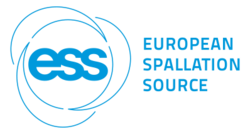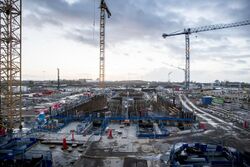Physics:European Spallation Source
Template:Infobox future infrastructure project
| Science with neutrons |
|---|
 |
| Foundations |
| Neutron scattering |
| Other applications |
| Infrastructure |
| Neutron facilities |
The European Spallation Source ERIC (ESS) is a multi-disciplinary research facility currently under construction.[1] The ESS is currently under construction in Lund, Sweden,[2] while its Data Management and Software Centre (DMSC) is situated in Copenhagen, Denmark.[3][4] The 13 European member countries are partners in the construction and operation of ESS.[5] ESS is scheduled to begin its scientific user program in 2023, with the construction phase set to be completed by 2025.[6] ESS will enable scientists to observe and understand basic atomic structures and forces, which is not achievable with other neutron sources in terms of lengths and time scales.[7] The research facility is located close to the Max IV Laboratory, which conducts synchotron radiation research. The construction of the facility began in the summer of 2014 and the first science results are planned for 2023.
During the operation, ESS will use nuclear spallation, a process in which neutrons are liberated from heavy elements by high energy protons. This is intrinsically a much safer process than uranium fission. This facility was an example of a "long pulse" source (milli-seconds). [8] [9]
The facility consists of a linear accelerator in which protons are accelerated and collide with a rotating, helium-cooled tungsten target, generating intense pulses of neutrons. Surrounding the tungsten are baths of cryogenic hydrogen which feed neutron supermirror guides. The operation is similar way to optical fibres, directing the intense beams of neutrons to experimental stations, where research is performed on a range of materials.
Neutron scattering can be applied to a range of scientific explorations in physics, chemistry, geology, biology, and medicine. Neutrons serve as a unique probe for revealing the structure and function of matter from the microscopic down to the atomic scale, with the potential for development of new materials and processes.
During the construction, ESS became a European Research Infrastructure Consortium, or ERIC, on 1 October 2015.
The European Investment Bank made a €50 million investment in European Spallation Source. This investment is supported by InnovFin-EU Finance for Innovators, an initiative established by the EIB Group in collaboration with the European Commission under Horizon 2020, the EU's research and innovation program.[10][11]
History
When the ISIS neutron source was built in England in 1985, its success in producing indirect images of molecular structures eventually raised the possibility of a far more powerful spallation source. By 1993, the European Neutron Scattering Association began to advocate what would be the most ambitious and broad-based spallation source in the world, ESS.[12]
Neutron science soon became a critical tool in the development of industrial and consumer products worldwide. So much so that the Organization for Economic Development (OECD), declared in 1999 that a new generation of high-intensity neutron sources should be built, one each in North America, Asia and Europe.[12] Europe's challenge was its diverse collection of national governments, and an active research community numbering in the thousands. In 2001, a European roadmap for developing accelerator driven systems for nuclear waste incineration estimated that the ESS could have the beam ready for users in 2010.[13] A European international task force gathered in Bonn in 2002 to review the findings and a positive consensus emerged to build ESS. The stakeholders group met a year later to review the task force's progress, and in 2003 a new design concept was adopted that set the course for beginning operations by 2019.[12]
Over the next five years a competitive and yet collaborative site selection process played out and Lund, Sweden was chosen as the preferred site; the definitive selection of Lund was announced in Brussels on 28 May 2009.[12] On 1 July 2010, the staff and operations of ESS Scandinavia were transferred from Lund University to 'European Spallation Source ESS AB', a limited liability company set up to design, construct and operate the European Spallation Source in Lund. The company's headquarters are situated in central Lund.[14]
ESS became a European Research Infrastructure Consortium, or ERIC, on 1 October 2015. The Founding Members of the European Spallation Source ERIC are the Czech Republic, Denmark, Estonia, France, Germany, Hungary, Italy, Norway, Poland, Spain, Sweden, Switzerland and United Kingdom.[15]
As of 2013 the estimated cost of the facility will be about €1.843 bn. Host nations Sweden and Denmark plan to give about half of the sum. However the negotiations about the exact contributions from every partner are still in progress.[16] From 2010 to 30 September 2015, ESS was operated as a Swedish aktiebolag, or AB.[12]
Site selection
Originally, three possible ESS sites were under consideration: Bilbao (Spain), Debrecen (Hungary) and Lund (Sweden).[17]
On 28 May 2009, seven countries indicated support for placing ESS in Sweden. Furthermore, Switzerland and Italy indicated that they would support the site in majority.[18] On 6 June 2009, Spain withdrew the Bilbao candidacy and signed a collaboration agreement with Sweden, supporting Lund as the main site, but with key component development work being performed in Bilbao. This effectively settled the location of the ESS; detailed economical negotiations between the participating countries are now taking place.[19] On 18 December 2009, Hungary also chose to tentatively support ESS in Lund, thus withdrawing the candidacy of Debrecen.[17][20]
The construction of the facility began in early 2014, with a ground-breaking event held in September of that year. The user programme will start in 2023, and it is planned to be fully operational by 2025.[6] ESS provides weekly updates of construction progress and live construction site webcams on its website.
The linear accelerator
The ESS uses a linear accelerator[21] (linac) to accelerate a beam of protons from the exit of its ion source at 75 keV to 2 GeV, at the entrance of the accelerator protons are traveling at ~1% of the speed of light and at the end of the accelerator, they reach a velocity of ~95% speed of light. The accelerator uses both normal conducting and superconducting cavities.
The normal conducting cavities are Radio Frequency Quadrupole, RFQ, working at a frequency of 352.21 MHz, and accelerating the proton beam up to an energy of 3.62 MeV. The next structure is a transport line for the medium energy protons, MEBT which transports the beam from the RFQ to the next structure for further acceleration. In the MEBT the beam properties are measured, the beam is cleaned from the transverse halo around the beam, and also the head and tail of the beam pulse are cleaned using a transversally deflecting electromagnetic chopper. The Drift Tube Linac, DTL, which is the structure downstream of the MEBT accelerates the beam further to ~90 MeV. At this energy, there is a transition from normal conducting cavities to superconducting cavities.
Three families of superconducting cavities accelerate the beam to its final energy of 2 GeV, firstly a section using double-spoke cavities up to an energy of ~216 Mev, then two families of elliptical cavities which are optimized for medium and high energy proton acceleration at a frequency of 704.42 MHz. Following the elliptical cavities, a transfer-line guides the beam to the target, and just before sending the beam to the target for producing spallation neutrons expands the beam and paints the target to dissipate the generated heat over a larger area.
The linac repetition rate is 14 Hz, and the pulses of protons are 2.86 ms long, making the duty factor of the linac 4%. The beam current within the pulse is 62.5 mA, and the average beam current is 2.5 mA.
Except in the RFQ which uses the same structure and field to accelerate and focus the beam, the transverse focusing of the beam of protons is performed using magnetic lenses. In the low energy beam transport, right after the ion source, magnetic solenoids are used, in the DTL permanent quadrupole magnets are used and the rest of the linac uses electromagnetic quadrupoles.
The spallation target and its environmental impact
- The ESS source will be built around a solid tungsten target, cooled by helium gas.[22][23][24]
- Radioactive substances will be generated by the spallation process, but the solid target makes the handling of these materials easier and safer than if a liquid target had been used.
- ESS, E.on, and Lunds Energi are collaborating in a project aiming to get the facility to be the world's first completely sustainable large-scale research centre through investment in wind power.[25] The ESS project is expected to include an extension of the Nysted Wind Farm.
- Radioactive material storage and transport will be required, but the need is much less than that of a nuclear reactor.
- ESS expects to be CO2-neutral.[26]
- Recent design improvements will decrease energy usage at ESS.[27][28]
Neutron Scattering and Imaging Instruments at ESS
The target station is surrounded by instrument halls with scientific instruments placed in four sections in the cardinal directions.[29] In the western section, science instruments are located 156 meters from the center of the target station. In the southern one, the distance is between 50 and 80 meters, and the science instruments located closest to the target station are in the northern and eastern sections.[29]
Initially, 15 different scientific instruments will be erected:[30]
Large-scale structures:
- ODIN (Imaging)[30]
- SKADI (General purpose SANS)[30]
- LoKI (Broadband SANS)[30]
- FREIA (Horizontal reflectometer)[30]
- ESTIA (Vertical reflectometer)[30]
- HEIMDAL (Powder diffractometer)[30]
- DREAM (Powder diffractometer)[30]
- BEER (Engineering diffractometer)[30]
- MAGiC (Magnetism diffractometer)[30]
- NMX (Macromolecular diffractometer)[30]
- CSPEC (Cold chopper spectrometer)[30]
- T-REX (Thermal chopper spectrometer)[30]
- BIFROST (Crystal analyser spectrometer)[30]
- VESPA (Vibrational spectrometer)[30]
- MIRACLES (Backscattering spectrometer)[30]
ESSnuSB
The ESS neutrino super beam project aims to generate the most powerful neutrino beam in the world.[31][32]
See also
- ISIS neutron source — Europe's only pulsed spallation source
- J-PARC - The world's most powerful spallation source, located in Japan
- MAX IV — synchrotron radiation facility in Lund
- Spallation Neutron Source
References
- ↑ "European Spallation Source - Homepage". ESS. 2014. http://europeanspallationsource.se/.
- ↑ European Spallation Source. "Construction Site Weekly Updates". http://europeanspallationsource.se/site-weekly-updates.
- ↑ European Spallation Source. "DMSC". http://europeanspallationsource.se/data-management-and-software.
- ↑ "Data Management & Software Centre - ESS". https://europeanspallationsource.se/data-management-software-centre.
- ↑ "ESS - Introduction". European Spalliation Source. 2013. http://europeanspallationsource.se/european-spallation-source.
- ↑ 6.0 6.1 European Spallation Source (April 2015). Activity Report 2015. Lund: ESS. http://europeanspallationsource.se/sites/default/files/ess_activity_report_2015_printer_version.pdf. Retrieved 17 July 2015.
- ↑ European Spallation Source. "Unique Capabilities of ESS". http://europeanspallationsource.se/unique-capabilities-ess.
- ↑ Mezei, Ferenc (1996). "The raison d'être of long pulse spallation sources". Journal of Neutron Research 6 (1–3): 3–32. doi:10.1080/10238169708200095.
- ↑ Mezei, Ferenc (1997). "Long pulse spallation sources". Physica B: Condensed Matter 234-236: 1227–1232. doi:10.1016/S0921-4526(97)00271-8. Bibcode: 1997PhyB..234.1227M.
- ↑ Bank, European Investment (2022-01-27) (in EN). EIB Activity Report 2021. European Investment Bank. ISBN 978-92-861-5108-8. https://www.eib.org/en/publications/activity-report-2021.
- ↑ "InnovFin EU Finance for innovators" (in en). https://www.eib.org/en/products/mandates-partnerships/innovfin/index.htm.
- ↑ 12.0 12.1 12.2 12.3 12.4 "The ESS Story". European Spallation Source. 2013. http://europeanspallationsource.se/ess-story.
- ↑ A European Roadmap for Developing Accelerator Driven Systems (ADS) for Nuclear Waste Incineration pretty layout with bad picturesugly layout with good pictures
- ↑ "The European Spallation Source | ESS". Europeanspallationsource.se. http://www.europeanspallationsource.se/european-spallation-source.
- ↑ European Spallation Source ERIC (20 August 2015). "European Commission Establishes ESS as a European Research Infrastructure Consortium". ESS. https://europeanspallationsource.se/article/european-commission-establishes-ess-european-research-infrastructure-consortium.
- ↑ FAQ Funding and Costs - ESS
- ↑ 17.0 17.1 "ESS Magyarország". Esshungary.eu. http://www.esshungary.eu/hirek_eng.html.
- ↑ "Clear support for ESS in Sweden: A great step for European science" (Press release). Ess-scandinavia.eu. May 29, 2009. Archived from the original on 7 June 2009.
- ↑ "Swedish-Spanish agreement on ESS in Lund the beginning of a new collaborative phase" (Press release). Ess-scandinavia.eu. 10 June 2009. Archived from the original on 21 December 2009.
- ↑ "Hungary will become the 14th Partner in the European Spallation Source research center. All three of the former site contenders now join forces to build the ESS in Sweden". http://ess-scandinavia.eu/news/320-former-site-contender-hungary-now-support-ess-in-lund.
- ↑ Garoby, Roland et al. (2018). "The European Spallation Source Design". Physica Scripta 93 (1): 014001. doi:10.1088/1402-4896/aa9bff. Bibcode: 2018PhyS...93a4001G.
- ↑ Moormann, Rainer; Bongardt, Klaus; Chiriki, Suresh (28 March 2009). "Safety aspects of high power targets for European spallation sources". Forschungszentrum Juelich. http://www2.fz-juelich.de/ua/datapool/page/466/IEF-6_Waste%20Disposal.pdf.[yes|permanent dead link|dead link}}]
- ↑ Moormann, Rainer; Reiche-Begemann, Sigrid (28 March 2009). "Safety and Licensing of the European Spallation Source (ESS)". Forschungszentrum Juelich. http://juwel.fz-juelich.de:8080/dspace/bitstream/2128/290/1/Juel_4136_Moormann.pdf.
- ↑ Physics World. "Sights firmly set on target". The Institute of Physics. http://live.iop-pp01.agh.sleek.net/physicsworld/reader/#!edition/editions_neutron-2015/article/page-9573.
- ↑ "Our unique Sustainable Energy Concept". http://ess-scandinavia.eu/ess-and-the-environment/a-unique-sustainable-energy-concept.
- ↑ Videnskab DK (22 July 2015). "Godt nyt for klimaet: Dansk-svensk forskningsanlæg vil være CO2-neutralt". http://videnskab.dk/teknologi/godt-nyt-klimaet-dansk-svensk-forskningsanlaeg-vil-vaere-co2-neutralt.
- ↑ European Spallation Source ERIC. "Innovation and Engineering Set ESS on Path to Sustainability". ESS. https://europeanspallationsource.se/article/reduced-energy-consumption-through-better-engineering-sets-ess-path-sustainability.
- ↑ Parker, T.. "ESS Energy Design Report 2013". ESS. https://europeanspallationsource.se/sites/default/files/20130131_ess_edr.pdf.
- ↑ 29.0 29.1 Peggs, Steven (2013). "The Reference Instrument Suite" (in English). ESS Technical Design Report. European Spallation Source. pp. 53–55. ISBN 978-91-980173-2-8. https://europeanspallationsource.se/sites/default/files/downloads/2017/09/TDR_online_ver_all.pdf.
- ↑ 30.00 30.01 30.02 30.03 30.04 30.05 30.06 30.07 30.08 30.09 30.10 30.11 30.12 30.13 30.14 30.15 Andersen, K.H. et al. (21 March 2020). "The instrument suite of the European Spallation Source" (in English). Nuclear Instruments and Methods in Physics Research Section A: Accelerators, Spectrometers, Detectors and Associated Equipment 957: 163402. doi:10.1016/j.nima.2020.163402. Bibcode: 2020NIMPA.95763402A.
- ↑ "Error: no
|title=specified when using {{Cite web}}". https://essnusb.eu/. - ↑ Alekou, A.; Baussan, E.; Kraljevic, N. Blaskovic; Blennow, M.; Bogomilov, M.; Bouquerel, E.; Burgman, A.; Carlile, C. J. et al. (December 2021). "Updated physics performance of the ESSnuSB experiment". The European Physical Journal C 81 (12): 1130. doi:10.1140/epjc/s10052-021-09845-8. ISSN 1434-6044. Bibcode: 2021EPJC...81.1130A.
Further reading
- S. Peggs et al. ESS Technical Design Report, April 2013.
- European Spallation Source. European Spallation Source Activity Report 2015, April 2015.
- European Spallation Source. Feature Series: The ESS Instrument Suite, 2014–2015.
- Hallonsten, O. 2012. Introduction: In pursuit of a Promise. In O. Hallonsten (ed.) In pursuit of a Promise: Perspectives on the political process to establish the European Spallation Source (ESS) in Lund, Sweden (pp 11–19). Lund: Arkiv Academic Press, 2012, p. 12.
- Prolingheuer, N.; Herbst, M.; Heuel-Fabianek, B.; Moormann, R.; Nabbi, R.; Schlögl, B., Vanderborght, J. 2009: Estimating Dose Rates from Activated Groundwater at Accelerator Sites. Nuclear Technology, Vol. 168, No. 3, December 2009, p. 924-930
- Heuel-Fabianek, B. 2014: Partition Coefficients (Kd) for the Modelling of Transport Processes of Radionuclides in Groundwater (PDF; 9,4 MB) JÜL-Berichte, Forschungszentrum Jülich, Nr. 4375, 2014, ISSN 0944-2952
- T. Parker. ESS Environmental Design Report, January 2013.
External links
- European Spallation Source website. The most up-to-date source for information on the ESS project.
- Weekly updates of the construction of ESS and live webcams at the construction site.
- "EU FP7 Preparatory Phase Project". http://www.ess-neutrons.eu/.
- essworkshop.org - See how the design of instrumentation for a future ESS-Scandinavia is moving forward.
- BrightnESS, EU grant project in support of ESS.
- SREss, EU grant project in support of ESS.
[ ⚑ ] 55°44′06″N 13°15′05″E / 55.7350°N 13.2514°E
 |






